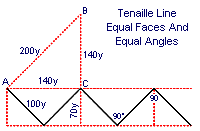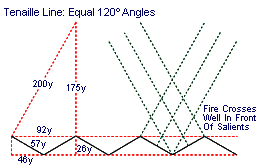Tenaille lines are continuous lines of entrenchment traced as
a series of faces joined to form alternate salient and re-entering angles.
They may also be taken as a series of more or less acute and obtuse redans
connected at the extremities of the redan faces. This type of line was developed
for the purpose of mitigating some of the more serious defects inherent to
regular redan lines by breaking the curtain between redans into two branches
and orienting the branch faces to project columns of fire more directly across
the redans' faces and salient angles. These redan lines with broken curtains
were traced as a basic redan lines with regularly formed redans; the curtains,
which were normally laid out as right lines connecting redan flanks, were
thrust forward at the center points with the branch faces laid out perpendicular
to the regular redans' faces to form a very obtuse
 (flattened) redan. Joseph Laisne described this pattern of
the tenaille line in which the salients of collaterals redans were 150 meters
(165 yards) apart, with regular redan faces 57 meters (62.71 yards) long
and branch redan faces 130 meters (143 yards) long. Capitals of the redans
were slightly over 48 meters (52.8yards) long with the demi-gorges of the
regular redans slightly under 30 meters (33 yards) long. Laisne's line was
laid out between two parallel lines 60 meters (66 yards) apart. The location
of the redan capitals were marked on the line (at intervals of 150 meters)
and diagonals laid out from the rear to the front line parallel lines that
joined collateral capitals. A distance of 32 meters (35.2 yards) was marked
out on the diagonals extending from every second capital to mark the extremities
of the regular redan faces. These faces were then marked from the diagonal
to the point where the line of the capital intersected the front parallel
line. Branch faces were then marked along the diagonal from the extremities
of the regular redan faces to the adjacent capitals. (flattened) redan. Joseph Laisne described this pattern of
the tenaille line in which the salients of collaterals redans were 150 meters
(165 yards) apart, with regular redan faces 57 meters (62.71 yards) long
and branch redan faces 130 meters (143 yards) long. Capitals of the redans
were slightly over 48 meters (52.8yards) long with the demi-gorges of the
regular redans slightly under 30 meters (33 yards) long. Laisne's line was
laid out between two parallel lines 60 meters (66 yards) apart. The location
of the redan capitals were marked on the line (at intervals of 150 meters)
and diagonals laid out from the rear to the front line parallel lines that
joined collateral capitals. A distance of 32 meters (35.2 yards) was marked
out on the diagonals extending from every second capital to mark the extremities
of the regular redan faces. These faces were then marked from the diagonal
to the point where the line of the capital intersected the front parallel
line. Branch faces were then marked along the diagonal from the extremities
of the regular redan faces to the adjacent capitals.
 A second type of tenaille line, primarily described
in pre-Civil War British manuals, was traced as a series of connected redans
all of which had equal angles at the salients and re-enterings and redan
faces all the same length. This repeating pattern imparts a sort of saw-tooth
appearance when projected on paper in plan view. There was no single basic
pattern that fixed the dimensions of the various elements of this type of
tenaille line, rather, the angles could be modified within certain limits
to cross columns of fire at varying distances from the redan salients.These
limits were established by the need, first, to prevent columns of fire projected
from each redan face from striking the face of the collateral redan and,
second, the need to cross columns of fire within effective musket range.
This necessarily gave a lower limit of 90° for the salients and
re-enterings, anything less would place redan faces within the line's columns
of fire, and an upper limit of 120°, more obtuse angles would produce
columns of fire that would partially over-lap, A second type of tenaille line, primarily described
in pre-Civil War British manuals, was traced as a series of connected redans
all of which had equal angles at the salients and re-enterings and redan
faces all the same length. This repeating pattern imparts a sort of saw-tooth
appearance when projected on paper in plan view. There was no single basic
pattern that fixed the dimensions of the various elements of this type of
tenaille line, rather, the angles could be modified within certain limits
to cross columns of fire at varying distances from the redan salients.These
limits were established by the need, first, to prevent columns of fire projected
from each redan face from striking the face of the collateral redan and,
second, the need to cross columns of fire within effective musket range.
This necessarily gave a lower limit of 90° for the salients and
re-enterings, anything less would place redan faces within the line's columns
of fire, and an upper limit of 120°, more obtuse angles would produce
columns of fire that would partially over-lap,
 but not effectively cross. More acute angles also tended to
produce redan faces that projected columns of fire closer to collateral redan
faces and salients; this had the effect of improving the close defense
characteristics of the line. Acute angles also increased the development
of the parapet, that is, the linear length of parapet required to complete
a line's continuous cover over a given stretch of ground as measured along
a right line from one extremity of the fortified ground to the other. A tenaille
line laid out with 90° angles required 100 yards of parapet for each
redan face (see illustration above) while a line laid out with 120°
angles required just 57 yards for each face; the more obtuse the angle became
the less time and material were required for construction of the line and
the few troops were required to defend it. but not effectively cross. More acute angles also tended to
produce redan faces that projected columns of fire closer to collateral redan
faces and salients; this had the effect of improving the close defense
characteristics of the line. Acute angles also increased the development
of the parapet, that is, the linear length of parapet required to complete
a line's continuous cover over a given stretch of ground as measured along
a right line from one extremity of the fortified ground to the other. A tenaille
line laid out with 90° angles required 100 yards of parapet for each
redan face (see illustration above) while a line laid out with 120°
angles required just 57 yards for each face; the more obtuse the angle became
the less time and material were required for construction of the line and
the few troops were required to defend it.
 D.
H. Mahan described a third type of tenaille line that was traced with alternating
large and small redans. There were two variations of this tenaille pattern
line depending on whether the large or the small redans were given 60°
salient angles. In either case the faces of the large redans were to be no
longer than 160 yards, the basic effective range of smoothbore muskets in
use when Mahan wrote his Treatise on Field Fortification. As was normal
with all works, the salients were never to be less than 60°. Faces of
the small redans were never supposed to be longer than 40 yards; that is,
they were limited to projecting columns of fire parallel to the large redan
faces that had a width one-quarter of the assumed effective range of small
arms. When the large redans were laid out with 60° salient angles their D.
H. Mahan described a third type of tenaille line that was traced with alternating
large and small redans. There were two variations of this tenaille pattern
line depending on whether the large or the small redans were given 60°
salient angles. In either case the faces of the large redans were to be no
longer than 160 yards, the basic effective range of smoothbore muskets in
use when Mahan wrote his Treatise on Field Fortification. As was normal
with all works, the salients were never to be less than 60°. Faces of
the small redans were never supposed to be longer than 40 yards; that is,
they were limited to projecting columns of fire parallel to the large redan
faces that had a width one-quarter of the assumed effective range of small
arms. When the large redans were laid out with 60° salient angles their
 capitals were to be 138 yards long and the distance between
the capitals of the large redan was to be 228 yards. When the small redans
had 60° salients the capitals of the large redans were to be 80 yards
long and the distance between capitals was to be 316 yards. Reference to
the illustration of Mahan's line with large redans should be enough to dispel
any notion that this line had any practical application whatsoever; the defenders
of the large redan faces would be in almost as much danger from their friends
as they were from an enemy. capitals were to be 138 yards long and the distance between
the capitals of the large redan was to be 228 yards. When the small redans
had 60° salients the capitals of the large redans were to be 80 yards
long and the distance between capitals was to be 316 yards. Reference to
the illustration of Mahan's line with large redans should be enough to dispel
any notion that this line had any practical application whatsoever; the defenders
of the large redan faces would be in almost as much danger from their friends
as they were from an enemy.
Although tenaille lines were supposed to improve the defects of
redan lines, the improvements produced even more defects. First and foremost,
tenaille lines' alternating salients and re-enterings offered double the
number of points of attack as regular pattern redan lines offered. Each redan
in a tenaille line was vulnerable to enfilade fire, a danger that increased
as the salient angles of the redans became more acute. The development of
parapet necessary to adequately cover a position required a heavy increase
in the amount of time, labor, and material necessary to construct the line
(as opposed to a regular redan line) and increased the number of troops necessary
to fully man the parapet. These defects tended to make the practical application
tenaille lines very difficult; they were rarely employed to fortify narrow
positions and never employed to fortify an extended position. Redan and
crémaillère lines required less time and labor to construct
and fewer troops to hold them, but were, generally, just as, if not more,
effective than tenaille lines for allowing the defenders to use their fire
to stop an attack. |